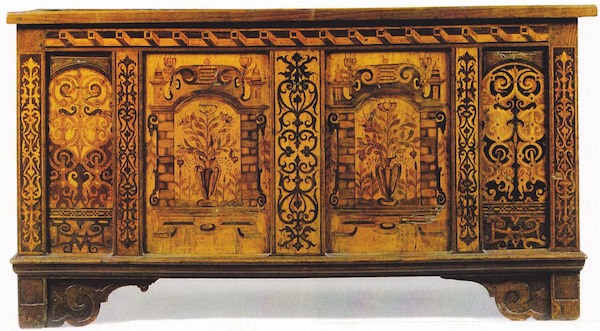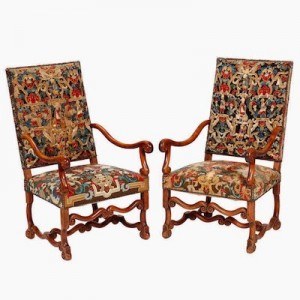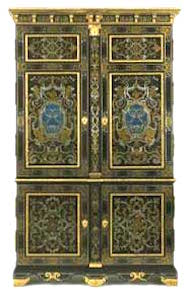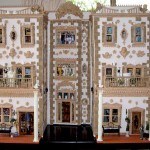
Two styles of Baroque vie for dominance – Italian and French. In furniture, I vote for the French Baroque dollhouse furniture. The long reign of King Louis XIV (171-1774) marked the beginning of a series of distinct period furniture styles, the first being Baroque. Some of the most beautiful and refined furniture ever made, displaying the highest level of artistic and technical ability, was created in Paris during the eighteenth century.
Furniture Guilds
High-quality furniture was insured by the guild system in France, which controlled all aspects of furniture design and construction. The guild had two divisions of craftsmen: the menuisiers (joiners), responsible for the making of solid wood furniture such as console tables, beds, and chairs; the ébénistes, from the word ébéne (ebony), were makers of veneered case pieces.
Two Important Words
Marquetry – This is a pattern of inlaid veneers of wood, brass, ivory, etc., fitted together to form a picture or design used chiefly as ornamentation in furniture. The Mazarin Writing Desk, 1685-1700. Is a good example, with marquetry of brass, ebony, ivory, mother-of-pearl, and clear tortoiseshell or horn with painted paper backing, on a pine carcass (unfinished piece).
Boulle – Andre Charles Boulle was a cabinet-maker to King Louis XIV and was one of the greatest of the ebinestes (workers in ebony), inlaying ebony wood with tortoiseshell, brass, and other metals until the whole resembled a brilliant mosaic. He further decorated his work with chiseled mounts of ormolu and bronze, carved and gilt ornaments. Marble and granite were used for table and console tops, and fine tapestries for upholstering, all combining to create a style in perfect harmony with the pomp and glittering splendor of the baroque Louis XIV age.
Suites of Furniture
Suites of furniture were designed for one reason: so hosts could facilitate “polite conversation,” no doubt wiling away the hours gossiping and discussing court matters. These groupings became the norm in luxurious, spacious apartments in France, complementing fabulous interiors and formal galleries and salons. Thus, Baroque settees became more stylistically integrated with the chairs, tables, and stools of a room. This idea of creating unified suites of furniture was a completely French innovation but caught on during the end of the Elizabethan era in England.
Settees and Sofas
Early settees were rectangular with high, straight backs, but Rococo curves were inching in from all sides. Visually, these long seats resembled two or three chairs joined together, with a solid back and all the busyness of 3 pairs of legs. But initially, this is exactly how they were made: chair-makers were creating “double chairs” and splicing together various wooden parts to give a unified look. Where previously, to sit side-by-side, people required a wooden bench, these first, fully upholstered settees combined comfort and community.
The stretchers of these settees were prime real estate for all the heavy, austere carving of the Baroque period, and the seatbacks were likewise a broad expanse for showing off decorative tapestry and needlepoint.
The term “sofa” first appeared around 1680. It is derived from its Turkish “divan”—a full-length bed with two sides, a back, and an ottoman that was covered in cushions and rich fabrics. Solid arms distinguish the sofa from the settle.
The sofa was the most important seating invention of the era, a time when chairs in the court were reserved only for royalty. Also propelling the sofa into popularity was the end of coffers as household fixtures. These decorative trunks were portable for travel, but also often doubled as long seats or beds in domestic situations.

Chairs
Chairs tended to be formal, with a high straight, and rectangular back. The arm supports joined the seat at the fore edge; the legs, were placed straight at the front corner of the seat rail. The upholstery, fastened with brass nails, would cover most of the chair’s frame. Slowly the shape of chairs began to change, becoming more graceful and comfortable.
With the arrival of the Régence style (ca. 1710–35), the strict rectangular form of the chairs was more symmetrical and had more curves, affecting the shape of the legs, which were now placed at an angle. The supports of the armrests were no longer placed directly above the legs but set back to accommodate the fashion of the hooped dress. The decoration became freer, and larger areas of the frame were carved with shell motifs, rosettes, and other ornaments in flat relief.
Tables
Tables varied greatly during the Baroque period but were often made of gilded wood, oak, or walnut. Large tables were long, rich, and sumptuous. Smaller ones were usually ornate and geometric. Tables of the Louis XIV furniture style had turned or pedestal feet, and later had curved legs. Small, round and oblong tables and consoles became common.
Cabinets and Commodes
Large cupboards in which to keep clothes and other objects had been in use in France for some time before this type of furniture was adapted in the later 17th century to serve in the rooms of the Royals.
The invention of chests of drawers, known as “commodes,” added permanence and formality to the life of the aristocracy. Commodes became essential pieces where one could stow clothes and belongings when not traveling,
There were many other forms of chests and cabinets in vogue. One was shaped like a sarcophagus (coffer), after the Italian Renaissance manner, and was set on carved scroll legs, like a table, with drawers beneath. A common form of the cabinet had a serpentine front and carved feet and panels and was decorated with Boulle work.
All cabinets could be elevated in stature, adding carved and inlaid panels.
Late Baroque
Toward the end of Louis XIV’s era, the styles changed, developing toward that of the styles of Regence furniture and the Rococo period of Louis XV furniture. The pedestal legs gave way to more slender, curved legs. Elaborate carving became an even more prominent feature, with a more graceful rococo and more scrollwork. In other respects very similar to the Louis XV style. However, this late Louis XIV work continued to show balanced details, while one of the distinguishing features of the succeeding reign is a balance of harmony, but not of detail.
In order to be as specific as possible with examples, all photos are of real pieces. You may also be interested in my article Baroque Interiors. I hope this quick overview of French Baroque furniture will be helpful to you.
by
Patrick Owens









